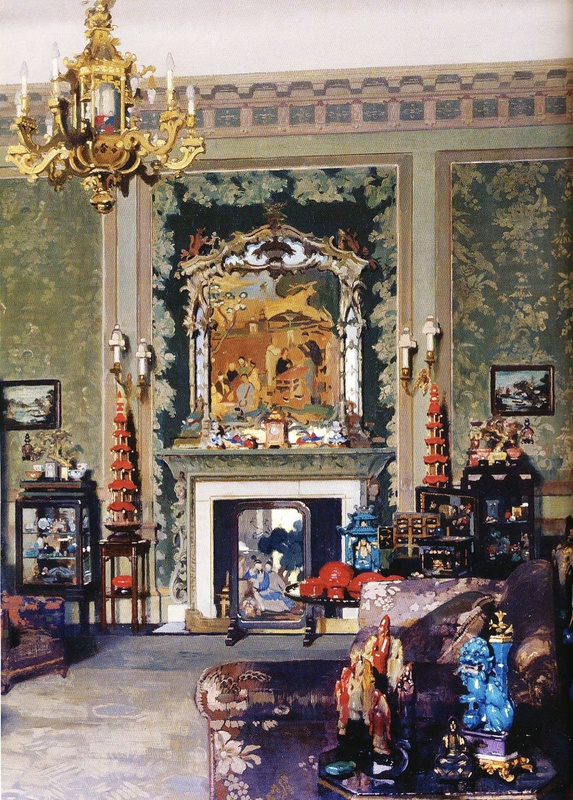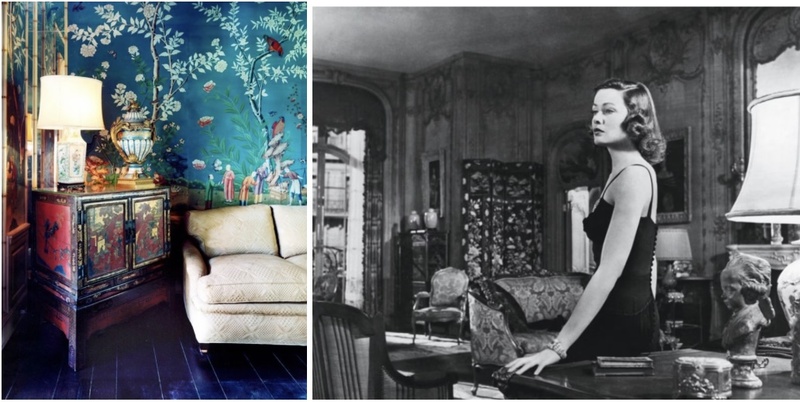The Penthouse, Inspiration
As for the Chinoiserie movement's introduction into the U.S., it was largely spread through Hollywood’s influences in film during the 1940s and 1950s. The glamour depicted in lavish set designs set the tone for what was elegant and inspired Americans to appear more "worldly" in order to replicate luxe looks on a budget with the stylishness they saw in movies as their cue.
Of the many features, Chinoiserie rooms contained pagoda-style architecture and gilded finishes. The art or paintings captured dream-like landscapes of the countryside, and figurines would span from dragons and animals to people's depictions.
Whereas the parlor room was to display a social reputation and level of wealth, these rooms were intended as a performance of global awareness, to a point, though they lacked much, if any, grounding in the realities of Eastern culture.

Queen Mary’s Chinese Chippendale Room, 1927. Oil, Richard Jack
Research Online, UK; ACD Sept. 2025
The Penthouse space conveys a strong tone of cultural hybridity and curated identity. With its golden wallpaper, pagoda-style framing of the window, and inclusion of figurines and instruments—such as the gong—the idea of the room at once suggests refinement of its imaginary globetrotters: or at the very least, the idea of wanting to be seen that way.
At the same time, there are clear Western distinctions at play in the rotary phone, modern style chairs, and grandfather clock, pointing to a mid-century American vision.
There is even a connection between the Victorian room and this one: a forgotten Chinese newspaper!
These balances offer an interesting insight into a design that still has so many impressions on our decorating schemes today!
Next, we will see how the Dollhouse grew during Mrs. Fisher's second installments!

![<a href="/omeka/items/browse?advanced%5B0%5D%5Belement_id%5D=50&advanced%5B0%5D%5Btype%5D=is+exactly&advanced%5B0%5D%5Bterms%5D=A+Photograph+of+the+Buddha+Statue+in+the+Penthouse%2C+created+by+Mrs.+Fisher%2C+%5Bca.+1940s-1950s%5D">A Photograph of the Buddha Statue in the Penthouse, created by Mrs. Fisher, [ca. 1940s-1950s]</a> <a href="/omeka/items/browse?advanced%5B0%5D%5Belement_id%5D=50&advanced%5B0%5D%5Btype%5D=is+exactly&advanced%5B0%5D%5Bterms%5D=A+Photograph+of+the+Buddha+Statue+in+the+Penthouse%2C+created+by+Mrs.+Fisher%2C+%5Bca.+1940s-1950s%5D">A Photograph of the Buddha Statue in the Penthouse, created by Mrs. Fisher, [ca. 1940s-1950s]</a>](https://omeka.wilkes.edu/omeka/files/square_thumbnails/8fb85739daf6be488349d829b723de76.jpg)
![<a href="/omeka/items/browse?advanced%5B0%5D%5Belement_id%5D=50&advanced%5B0%5D%5Btype%5D=is+exactly&advanced%5B0%5D%5Bterms%5D=A+Zoom+Capture+of+the+Gong+in+the+Penthouse%2C+created+by+Mrs.+Fisher%2C+%5Bca.+1940s-1950s%5D">A Zoom Capture of the Gong in the Penthouse, created by Mrs. Fisher, [ca. 1940s-1950s]</a> <a href="/omeka/items/browse?advanced%5B0%5D%5Belement_id%5D=50&advanced%5B0%5D%5Btype%5D=is+exactly&advanced%5B0%5D%5Bterms%5D=A+Zoom+Capture+of+the+Gong+in+the+Penthouse%2C+created+by+Mrs.+Fisher%2C+%5Bca.+1940s-1950s%5D">A Zoom Capture of the Gong in the Penthouse, created by Mrs. Fisher, [ca. 1940s-1950s]</a>](https://omeka.wilkes.edu/omeka/files/square_thumbnails/6474ada3578bbd46df86148531818f0b.jpg)
![<a href="/omeka/items/browse?advanced%5B0%5D%5Belement_id%5D=50&advanced%5B0%5D%5Btype%5D=is+exactly&advanced%5B0%5D%5Bterms%5D=A+Zoom+Capture+of+the+Pagoda+Style+Frame+Balcony+in+the+Penthouse%2C+created+by+Mrs.+Fisher%2C+%5Bca.+1940s-1950s%5D">A Zoom Capture of the Pagoda Style Frame Balcony in the Penthouse, created by Mrs. Fisher, [ca. 1940s-1950s]</a> <a href="/omeka/items/browse?advanced%5B0%5D%5Belement_id%5D=50&advanced%5B0%5D%5Btype%5D=is+exactly&advanced%5B0%5D%5Bterms%5D=A+Zoom+Capture+of+the+Pagoda+Style+Frame+Balcony+in+the+Penthouse%2C+created+by+Mrs.+Fisher%2C+%5Bca.+1940s-1950s%5D">A Zoom Capture of the Pagoda Style Frame Balcony in the Penthouse, created by Mrs. Fisher, [ca. 1940s-1950s]</a>](https://omeka.wilkes.edu/omeka/files/fullsize/5c3d785720494ab9e6c0e80598919d68.jpg)
![<a href="/omeka/items/browse?advanced%5B0%5D%5Belement_id%5D=50&advanced%5B0%5D%5Btype%5D=is+exactly&advanced%5B0%5D%5Bterms%5D=A+Zoom+Capture+of+the+Grandfather+Clock+in+the+Penthouse%2C+created+by+Mrs.+Fisher%2C+%5Bca.+1940s-1950s%5D">A Zoom Capture of the Grandfather Clock in the Penthouse, created by Mrs. Fisher, [ca. 1940s-1950s]</a> <a href="/omeka/items/browse?advanced%5B0%5D%5Belement_id%5D=50&advanced%5B0%5D%5Btype%5D=is+exactly&advanced%5B0%5D%5Bterms%5D=A+Zoom+Capture+of+the+Grandfather+Clock+in+the+Penthouse%2C+created+by+Mrs.+Fisher%2C+%5Bca.+1940s-1950s%5D">A Zoom Capture of the Grandfather Clock in the Penthouse, created by Mrs. Fisher, [ca. 1940s-1950s]</a>](https://omeka.wilkes.edu/omeka/files/square_thumbnails/27f6d144a27bf271f4355c42f404f4d6.jpg)
![<a href="/omeka/items/browse?advanced%5B0%5D%5Belement_id%5D=50&advanced%5B0%5D%5Btype%5D=is+exactly&advanced%5B0%5D%5Bterms%5D=A+Zoom+Capture+of+the+Radial+Phone+in+the+Penthouse%2C+created+by+Mrs.+Fisher%2C+%5Bca.+1940s-1950s%5D">A Zoom Capture of the Radial Phone in the Penthouse, created by Mrs. Fisher, [ca. 1940s-1950s]</a> <a href="/omeka/items/browse?advanced%5B0%5D%5Belement_id%5D=50&advanced%5B0%5D%5Btype%5D=is+exactly&advanced%5B0%5D%5Bterms%5D=A+Zoom+Capture+of+the+Radial+Phone+in+the+Penthouse%2C+created+by+Mrs.+Fisher%2C+%5Bca.+1940s-1950s%5D">A Zoom Capture of the Radial Phone in the Penthouse, created by Mrs. Fisher, [ca. 1940s-1950s]</a>](https://omeka.wilkes.edu/omeka/files/square_thumbnails/8b33f526a91ac6a0003d5749e0deab6b.jpg)
![<a href="/omeka/items/browse?advanced%5B0%5D%5Belement_id%5D=50&advanced%5B0%5D%5Btype%5D=is+exactly&advanced%5B0%5D%5Bterms%5D=A+Zoom+Capture+of+a+Newspaper+in+the+Penthouse%2C+created+by+Mrs.+Fisher%2C+%5Bca.+1940s-1950s%5D">A Zoom Capture of a Newspaper in the Penthouse, created by Mrs. Fisher, [ca. 1940s-1950s]</a> <a href="/omeka/items/browse?advanced%5B0%5D%5Belement_id%5D=50&advanced%5B0%5D%5Btype%5D=is+exactly&advanced%5B0%5D%5Bterms%5D=A+Zoom+Capture+of+a+Newspaper+in+the+Penthouse%2C+created+by+Mrs.+Fisher%2C+%5Bca.+1940s-1950s%5D">A Zoom Capture of a Newspaper in the Penthouse, created by Mrs. Fisher, [ca. 1940s-1950s]</a>](https://omeka.wilkes.edu/omeka/files/fullsize/f47420467024e99c58f76c088fba8dc3.jpg)